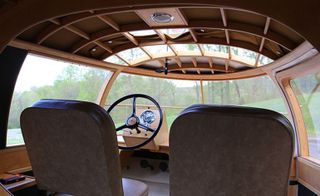Espousing Oddity: piloting Buckminster Fuller’s futuristic Dymaxion car

Back in the 1930s and 40s, famed visionary, neologist, and “comprehensive, anticipatory design scientist” Buckminster Fuller predicted a world populated by prefabricated metal dome houses built on stilts, and floating cloud cities built inside of polyethelyne spheres. Like so many prognostications of our collective destiny, Bucky’s visions did not exactly come to pass. But his radical ideas did influence generations to come.
The same can be said, in some ways, for his sole automotive design. Though, after getting behind the wheel of an exquisitely rendered replica of his 1933 Dymaxion car—commissioned by Jeff Lane of Nashville's Lane Motor Museum and built over the course of eight years—I’m not sure if that’s necessarily a good thing.
The Dymaxion Car (the name is a contraction of Dynamic, Maximum, and Tension) was meant to be a re-envisioning of the automobile, one reflective of Streamline Moderne notions of aerodynamics, packaging, efficiency, and engineering. As such, its body was a sleek teardrop shape, skinned in aluminum over a wooden frame. In order to maximize interior volume and enhance forward visibility, the engine was placed at the rear of the vehicle, though it drove the front wheels through a three speed manual gearbox. Since the 180-degree canopy of Perspex windows didn’t open, a retractable canvas roof provided ventilation, as did an air inlet around the headlamp. (A tray behind the inlet would support a block of ice, for an early form of passive air conditioning.) In order to minimize the turning radius of the eighteen-foot-long road-going dirigible, the steering system manipulated the single rear wheel.
All of this contributed to a purported ability of its 85-hp, flathead Ford V-8 to provide thirty miles of travel on a single gallon of gas, though this—like Fuller’s claim that the car could travel at 120 miles per hour and seat eleven people—may only have been true under certain circumstances, such as in Bucky’s sleep-deprived reveries. (The man made a spiritual practice of only sleeping a few hours a night.) The rear-wheel steering did allow for nearly perpendicular maneuvers, which wowed onlookers and helped drive orders, and deposits, when the vehicle was demonstrated to the public. But it also made the car incredibly unstable. The first prototype crashed during an early outing at the 1933 Chicago World’s Fair, rolling over and killing the driver, despite the fact that he was wearing a seatbelt.
Perhaps Fuller was attempting to maximize material efficiency, another of his inveterate obsessions, by forcing drivers to travel at speeds below 12 m.p.h. Or, given his interest in mysticism, maybe he simply encased his transcendent spirit in every Dymaxion and was communicating his visionary will to me via something he called “non-sinusoidal waveforms.” If so, then, mission accomplished. Otherwise, I was simply petrified.
Read the rest of this article on The Drive

The Drive got behind the wheel of an exquisitely rendered replica of Fuller’s 1933 Dymaxion car—commissioned by Jeff Lane of Nashville’s Lane Motor Museum and built over the course of eight years.

The Dymaxion Car was meant to be a re-envisioning of the automobile, one reflective of Streamline Moderne notions of aerodynamics, packaging, efficiency, and engineering. As such, its body was a sleek teardrop shape, skinned in aluminum over a wooden frame.

Fuller’s claim that the car could travel at 120 miles per hour and seat eleven people may only have been true under certain circumstances, such as in its designers sleep-deprived reveries.
Wallpaper* Newsletter
Receive our daily digest of inspiration, escapism and design stories from around the world direct to your inbox
-
 Gucci’s ‘Design Ancora’ reimagines furniture classics in rich red
Gucci’s ‘Design Ancora’ reimagines furniture classics in rich redGucci launches new editions of Italian design icons in an alluring deep red, showcased during Milan Design Week 2024
By Simon Mills Published
-
 Loewe’s Jonathan Anderson drafts artists to create 24 extraordinary lamps at Milan Design Week 2024
Loewe’s Jonathan Anderson drafts artists to create 24 extraordinary lamps at Milan Design Week 2024Loewe creative director Jonathan Anderson commissioned international artists and artisans to explore ‘illumination within the house’ with a series of lamps and lighting installations, shown at a group exhibition at Milan Design Week 2024
By Scarlett Conlon Published
-
 What are polynucleotides? Trying the skin injectable made from salmon sperm
What are polynucleotides? Trying the skin injectable made from salmon spermPolynucleotides are the latest in skin injectables, containing DNA derived from the gonads of salmon. Wallpaper* Beauty & Grooming Editor Hannah Tindle tries them to discover exactly how they work
By Hannah Tindle Published